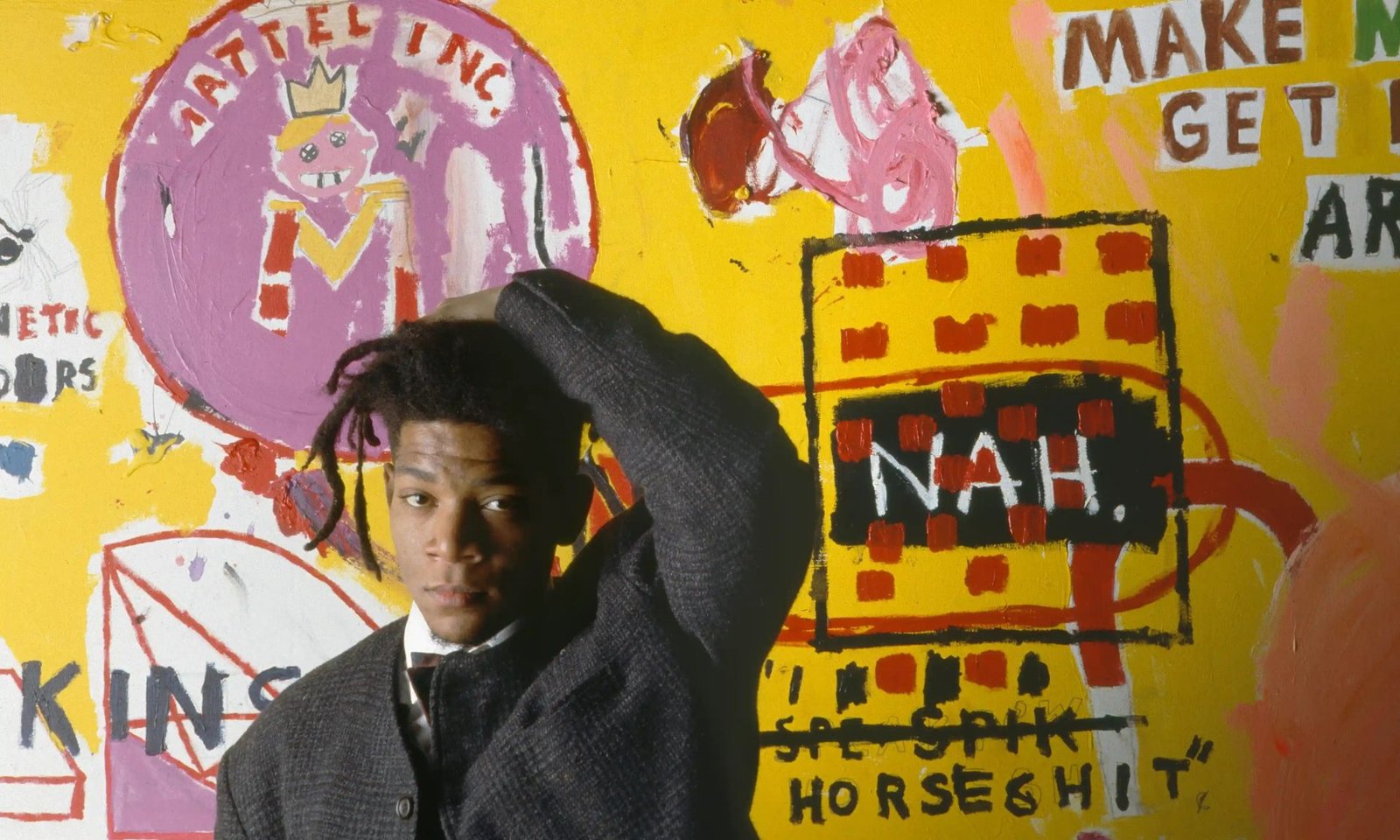Jean-Michel Basquiat’s 20 Most Evocative Paintings
Discover the raw intensity and social commentary in Basquiat's top 20 daring works.
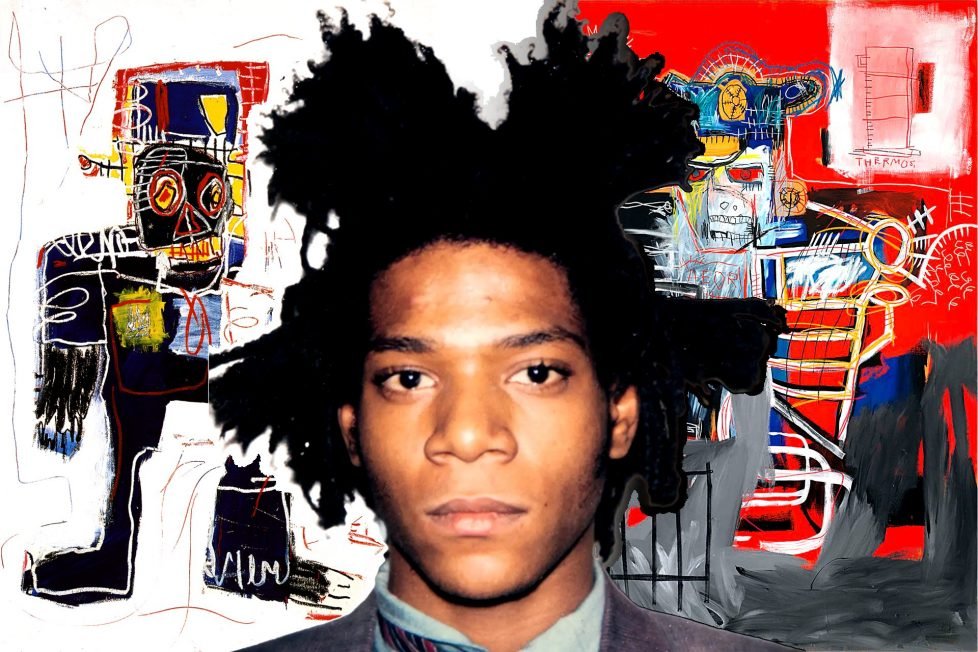
Discover the raw intensity and social commentary in Basquiat's top 20 daring works.

Table of Contents
ToggleFrom Brooklyn’s hard pavements to the lofty halls of the art world, Jean-Michel Basquiat marked his presence by defying convention. A game-changer, and a provocateur – he was an artist who spoke his truth through his creations. His raw talent and unique style made him one of the most significant artists of the 20th century, his work standing as a searing indictment of social inequality and racial injustice.
Basquiat’s legacy extends beyond the deep emotion and striking beauty of his art. It is cemented by the fact that many of his pieces are tucked away in valued private collections all over the world.
Each of Basquiat’s works is highly prized, and being able to see one up close is a rewarding and intriguing experience.This intrigue hit fever pitch when the FBI swooped down on an Orlando Museum, seizing all 25 works from their Jean-Michel Basquiat collection. Doubts surrounded their origin and authenticity, casting long shadows over another facet of the art world: near-perfect fakes.
So why does Basquiat continue to captivate us, decades after his untimely death? And what makes his work resonate with such power? Join us as we explore these burning questions, journeying through 20 of his most evocative paintings – each one a testament to an artist who forever changed the landscape of contemporary art.
“Cadillac Moon” is a prime example of Jean-Michel Basquiat’s early artistic brilliance, painted in 1981. This unique artwork came about as a side product during the production of “Downtown 81”, a film mirroring Basquiat’s own struggle as a burgeoning artist and musician. Basquiat effectively used the paint and canvases provided by the production to create pieces that were showcased as his character’s works in the movie.
“Cadillac Moon” fascinated Blondie’s Debbie Harry so much that she acquired it for $200 after the film’s completion. The painting reflects a restless rhythm, just like a chaotic TV show. In it, a fleet of TV screens featuring varied faces consumes the right side, while an abstractly rendered Cadillac holds fort in the upper left corner.
Basquiat showed a playful mockery towards his SAMO© tag, crossing it out, then subtly hinting at African-American baseball star, Hank Aaron. This painting marked Basquiat’s significant transition from gritty street artist to gallery sensation – a substantial shift in his career. It distinctly showcases Basquiat’s early trials, evolving style, and the dynamic New York art scene of the early ’80s.
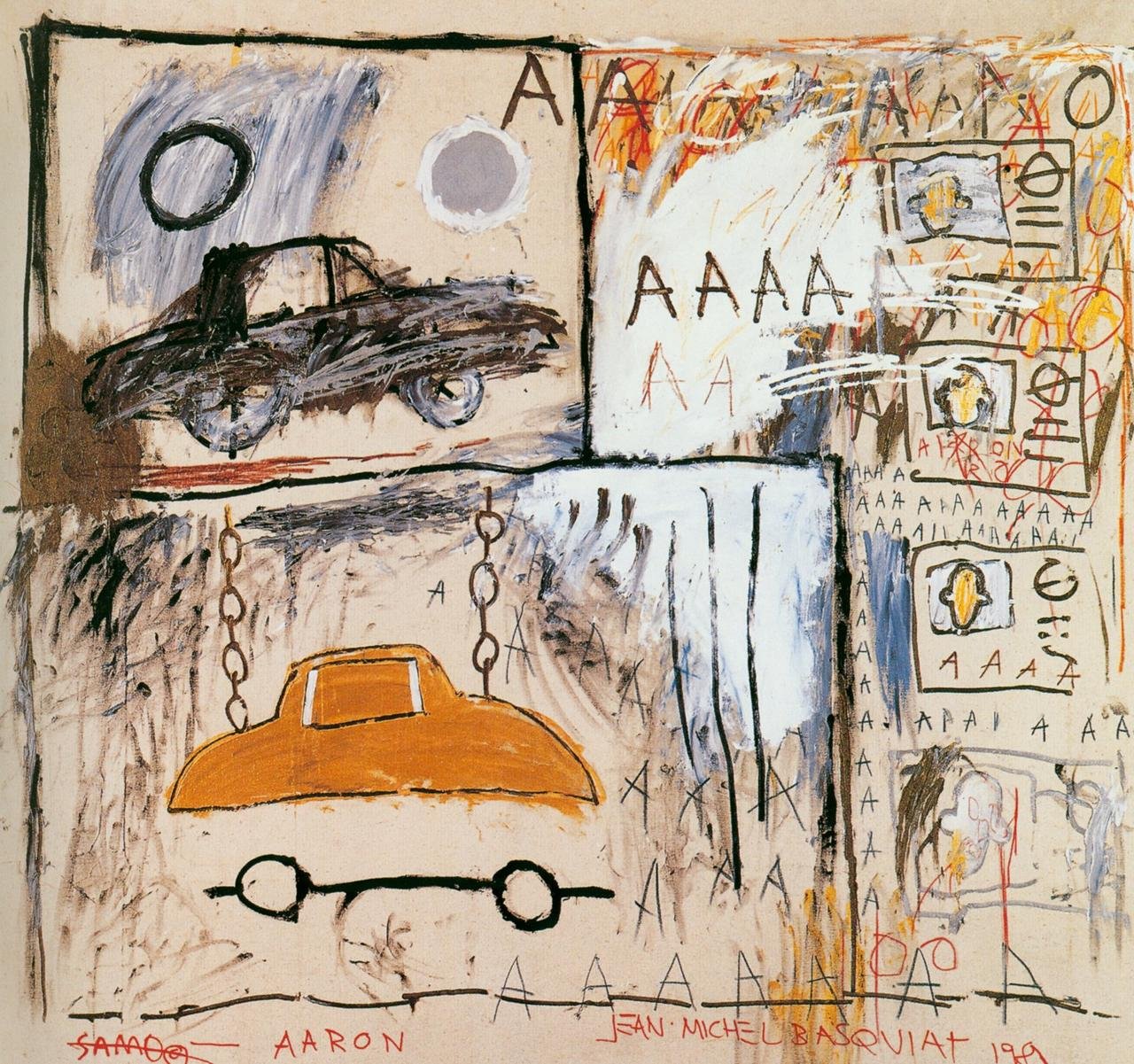
“Irony of a Negro Policeman”, confronts the questions of race and power. It’s bold, it’s daring, and it homes in on a raw truth. With his art, Basquiat gave the Black figure center stage because, in his words, they were never really portrayed realistically or enough in modern art. This piece is a potent critique.
It’s a Black policemen’s portrayal – an African-American enforcing rules that paradoxically were enacted to oppress his race. The irony is piercing and willfully emphasized by Basquiat. The policeman in his painting is a distant, authoritarian figure. The face is akin to a mask, and the hat, uncannily, mirrors a cage.
One can’t ignore the stinging words, “IRONY OF NEGRO PLCEMN” on the right side. The word “Pawn” sits at the bottom right, highlighting how Basquiat perceives this role – a distressing illustration of systemic oppression.
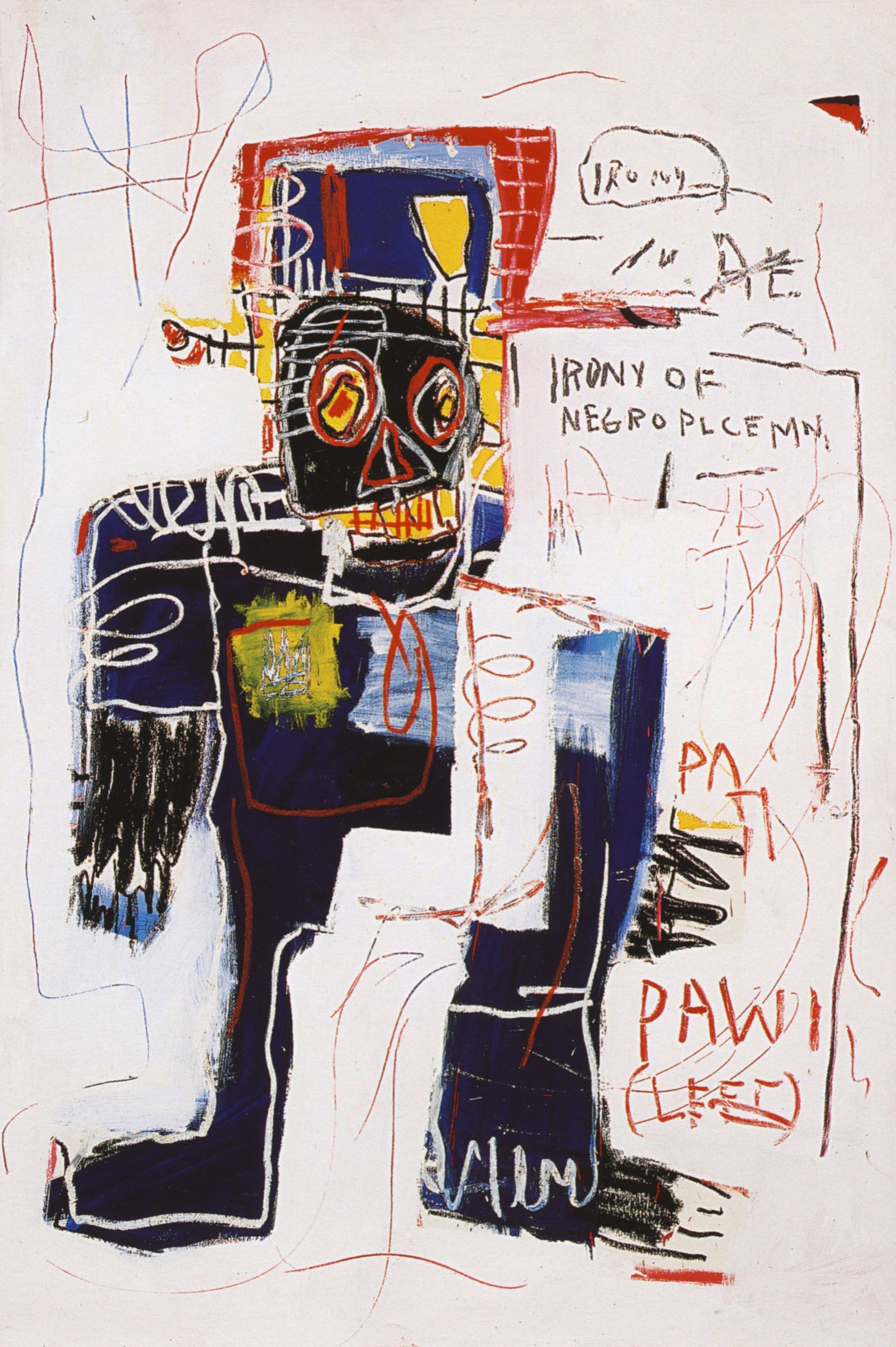
In “La Hara” Basquiat diverted from his common theme of Black subjects to paint an imposing skeletal White figure, no doubt the harsh, raw essence of authority.
Sporting a peaked cap, the figure almost glows against a burning red backdrop. It’s pumped full of Basquiat’s signature starkly vivid colors and diagram-like chaos. The phrase “LA HARA” echoes loudly on the left, a homage to Basquiat’s Puerto Rican heritage. It’s an insider street word for the cops, borrowed from “la jara”. This Spanish term cleverly disguises a play on “O’Hara”, a classic Irish surname and a stereotype for New York police officers back in the 40’s and 50’s.
A looming gray sits at the painting’s base, steel bars gritty as city pavement. Did these restrict or protect? That’s for the viewer to decide. The hefty $35 million price tag it fetched at Christie’s in 2017 is proof of its intense visual dialogue and strong societal commentary. This isn’t just a painting – it’s a mirror held up to the past, reflecting our present.
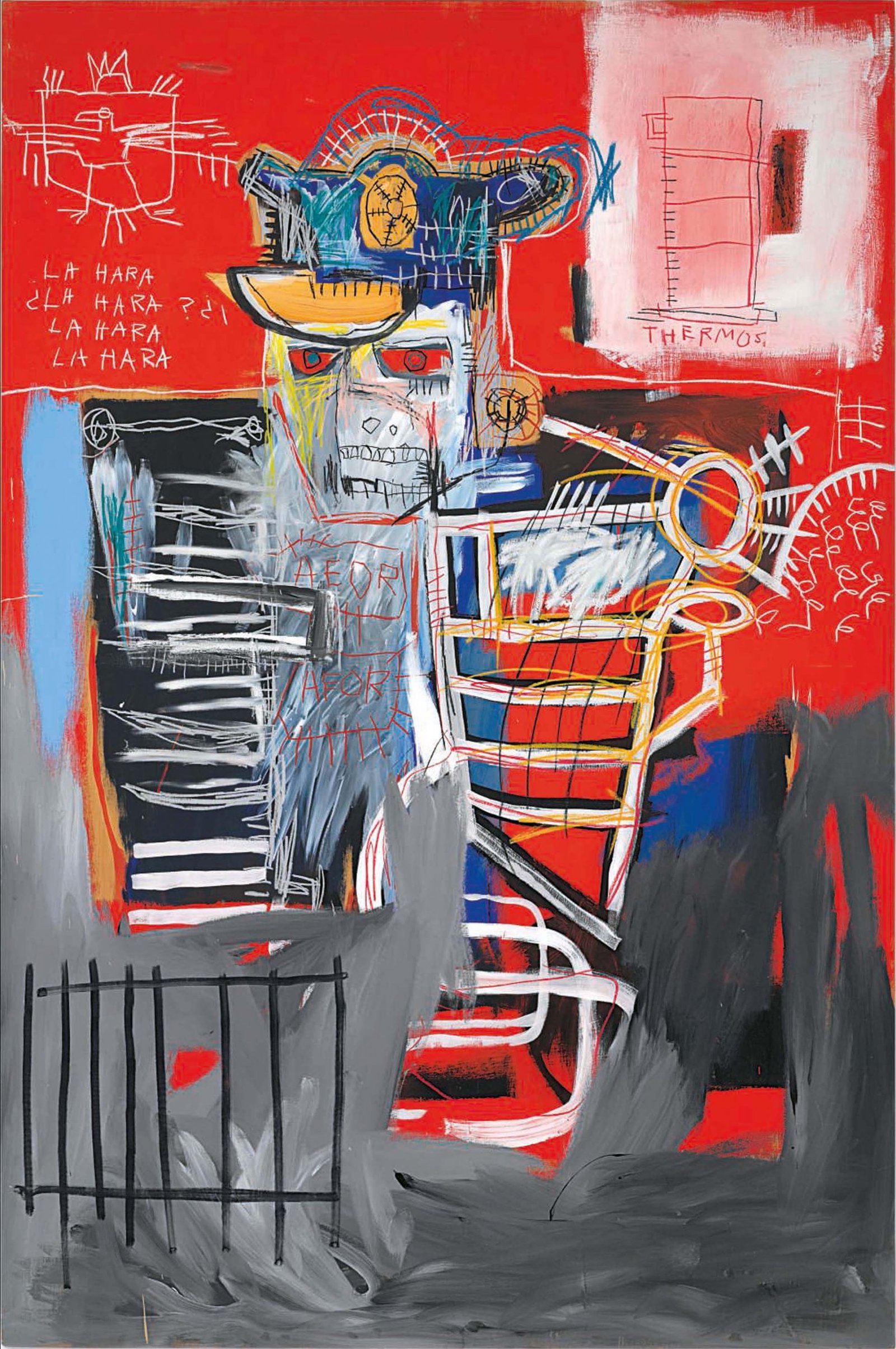
Bursting with bold hues, “Untitled (Fallen Angel)” is a melting pot of jagged lines and rounded forms. It’s edgy and pure Basquiat. Look for Native American overtones, an echo of his cultural explorations.
The central figure, an angel, is strikingly human. Check out the facial details and yes…a penis. Take note of the talon-like hands and feet and stark blue skyline. The jagged halo adds to the mystery. Barbed wire, a crown of thorns, or just a rope? The painting tells the story of color warfare. Red, yellow, black, and white clash, conjuring chaos and danger. The angel, while in flight, looks about ready to crash.
Basquiat’s angel is similar to his other figures, skeletal, yet intriguing, reflecting his personal struggles. Basquiat loaded his works with his unique experiences. This angel illustrates his defiance, triumphs, struggles, and roots.
He explored the here-and-now through classical symbols. The angel was no divine tribute, but a symbol of a Black man’s experiences in America. Welcome to Basquiat’s world, where every stroke tells a story. Indeed, “Untitled (Fallen Angel)” is a shining beacon of his brilliant, chaotic, and tragically short career.
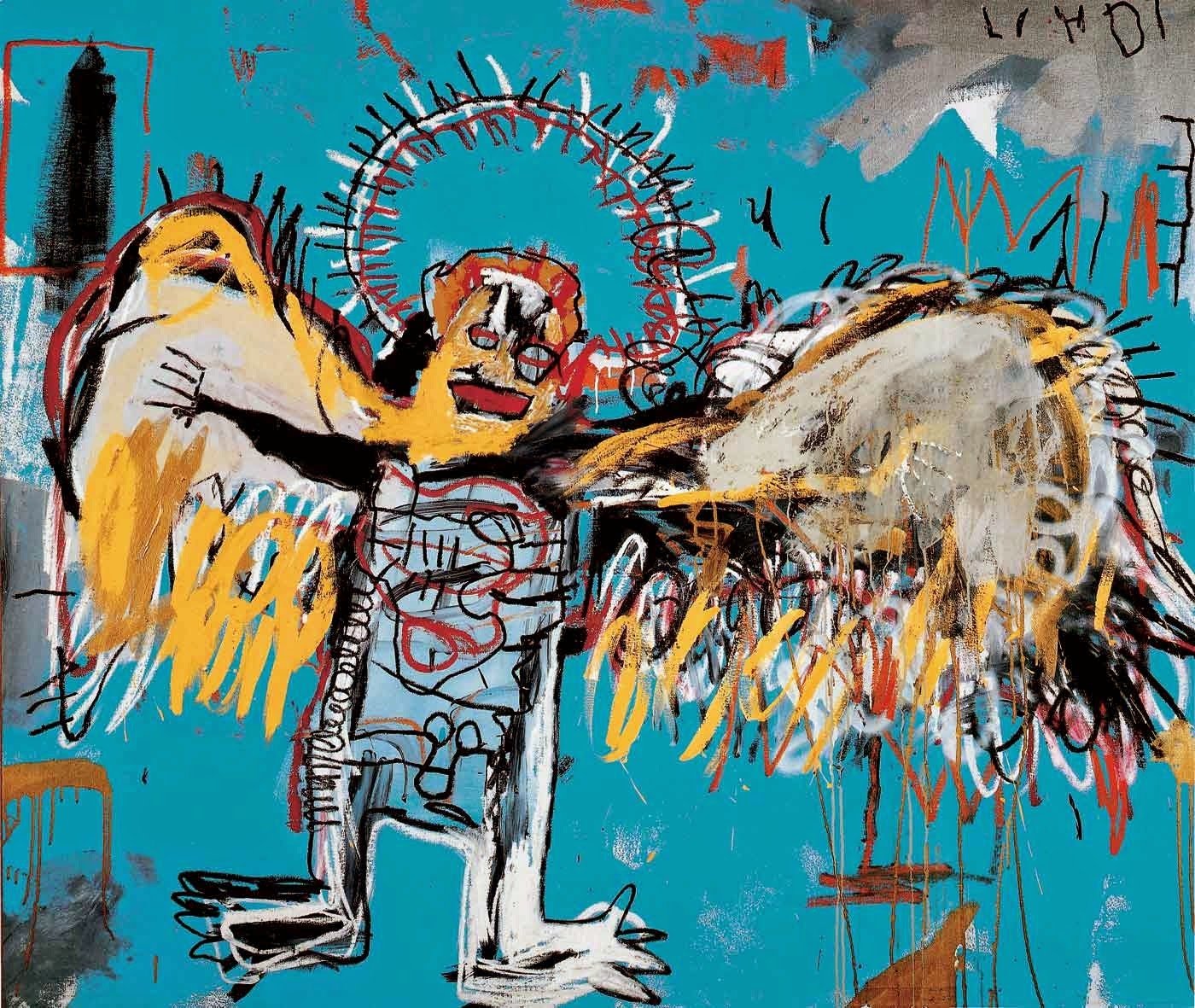
“Untitled (Skull Painting)” shows typical Basquiat bravura. Created at the age of twenty, it reveals early canvas magic. Unlike speedy sketches, this artwork took months to complete. In the painting, inner and outer life clash. The jaw, like a skull, bears exposed teeth. Yet, eyes, ears, and hair hint at a living being. Intriguing areas within the skull imply a facial perception. It’s as if we glimpse both inside and out – a vision alive yet lifeless.
The deep, black skin frames the vivid yellow jawbone and orange teeth. Despite this color pop, the piece radiates a dismal aura. Through Basquiat’s “Untitled”, we see the morbid, yet vibrant, duality of life and art.
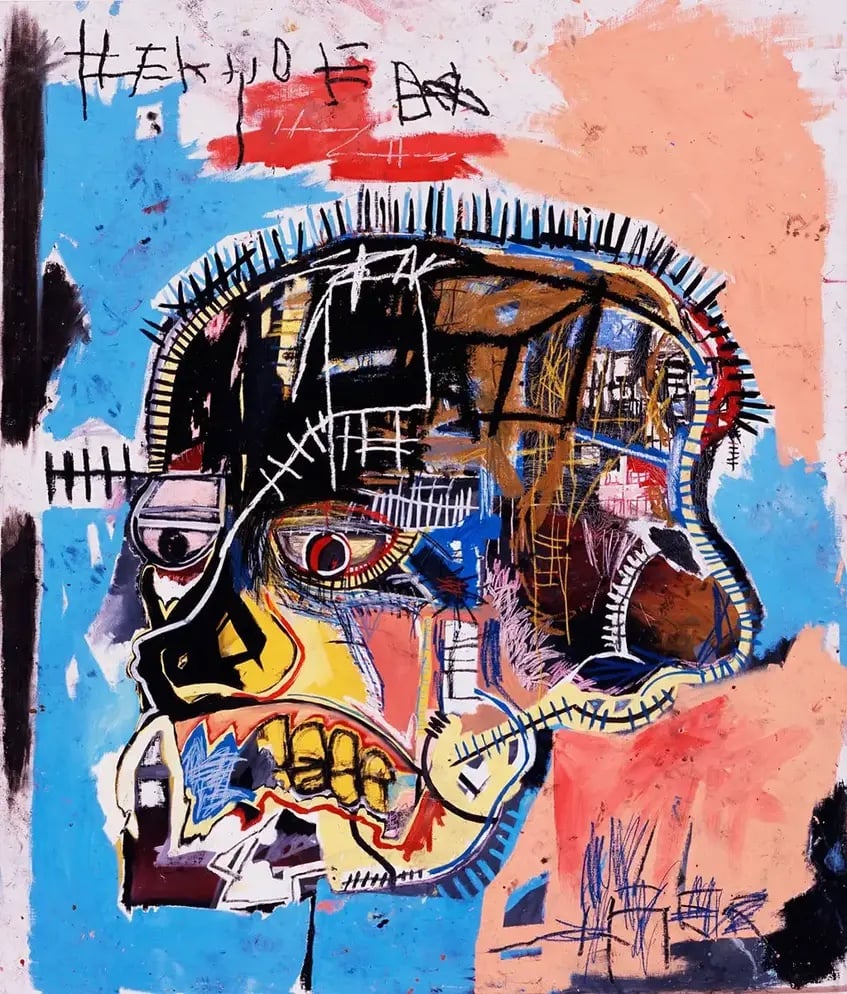
In Basquiat’s “Untitled (Skull Painting)”, 1982, his rich artistic skills are brought to life with each frenzied stroke. Crossed-out games of tic-tac-toe are nestled within over-layered and overpainted text. These elements form a balance against the noticeable letters at the bottom. His graphic symbols feel like a primitive language, hovering in the world of symbolic expression – words almost, yet not quite formed.
A key example is the bold black “A” scrawled on the bottom left. It’s presented almost like the title or beginning of something. The vivid colors may draw your gaze initially. But look carefully, and you’ll spot Basquiat’s famous tag – the three-pointed crown – shadowed in the background, its outline drawn up with an oil stick.
“Untitled (Skull Painting)” made history in 2017 when it sold at Sotheby’s for $110.5 million, making it the sixth priciest painting ever auctioned and marking it Basquiat’s most expensive painting.
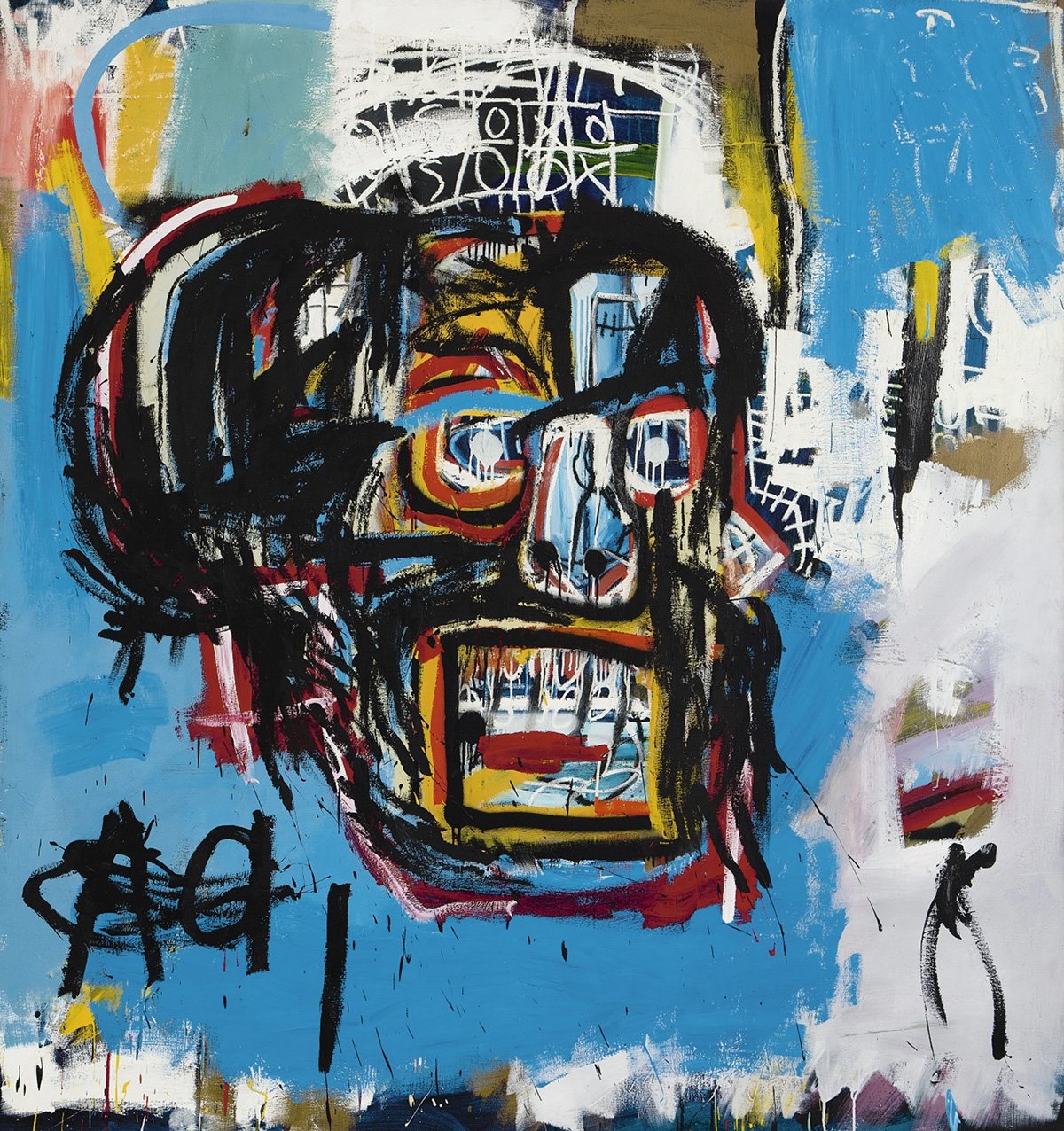
For the past four decades, “Equals Pi” was lost from public sight, housed in private collections. It only just resurfaced as a highlight in a recent Tiffany’s “ABOUT LOVE” campaign starring Beyoncé and JAY-Z.
The painting’s previous owners weren’t strangers to the world of jewels. Italian duo Alberto and Stefania Sabbadini, themselves jewelry moguls, bought it at a London Sotheby’s auction in 1996. They parted with a cool $253,000 in exchange for this art gem.
Now, it seems to have found its final docking port in the hands of Bernard Arnault, CEO of Tiffany’s parent company, LVMH. Arnault is a prominent figure in the art circles, holding a key spot amongst the globe’s top art collectors.
“Equals Pi ” was brought to life in 1982, a year considered holy grail for Basquiat enthusiasts. It traps the eye with Basquiat’s iconic crown and a head, with doodled phrases like “AMORITE”, “TEN YEN”, and “DUNCE”. The title “Equals Pi” isn’t random; it’s a subtle reference to mathematical equations scribbled on the right side of the work. The reference to “DUNCE” links to cone-shaped dunce caps concealed in the painting, adding layers to this unique work.
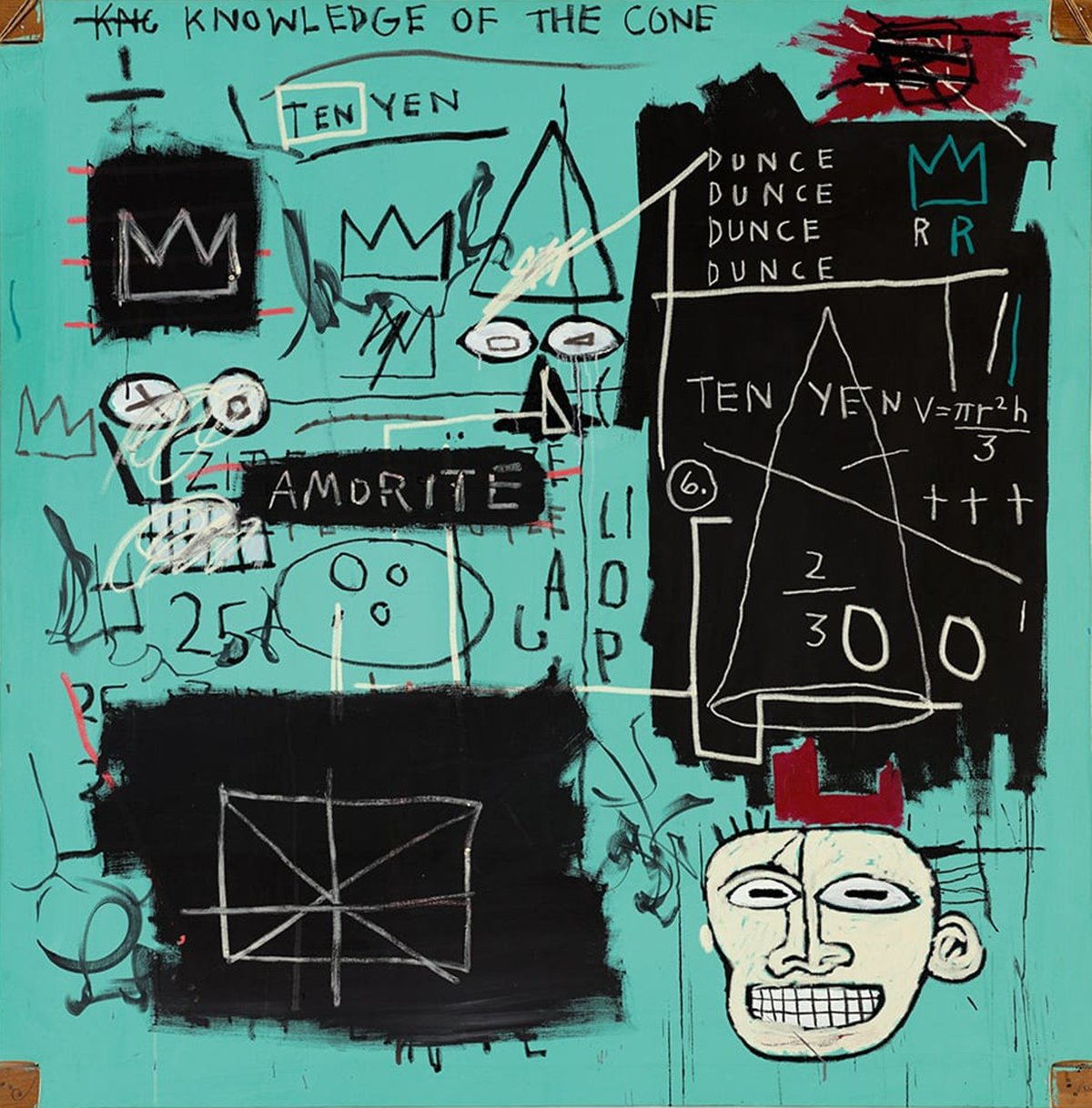
“Boy and Dog in a Johnnypump” is not just a painting, it’s a piece of history. The canvas looms large at 14 feet wide and 8 feet high. The central figures – a skeletal boy and his dog – command your attention. They stand at the center, playing in the spray from an open fire hydrant. “Johnnypump” is New York slang for an open fire hydrant, giving city kids a fun, refreshing summer escape. Take a look at the color palette. The warm array of reds, orange, and yellows capture a scorching summer’s day.
This artwork fetched a cool $100 million in 2020. It ranks as Basquiat’s second most expensive work, only losing the top spot to his “Untitled” (1982) that sold for a jaw-dropping $110.5 million in 2017.
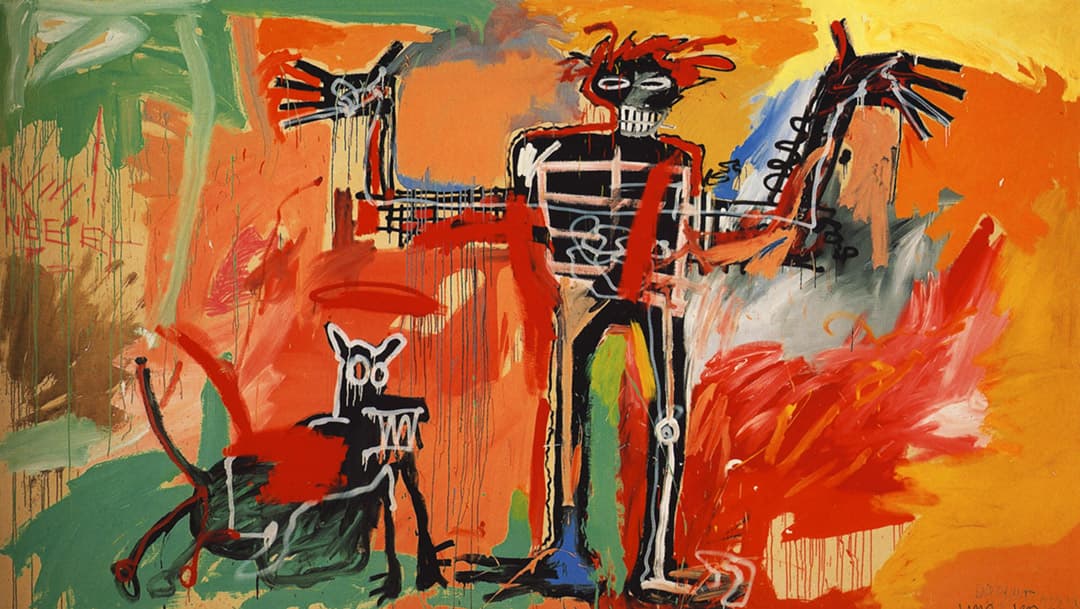
“Dustheads” presents a turbulent world. This dramatic piece centers on two “angel dust” addicts, surrounded by pitch blackness. These agitated figures are believed to be friends of Basquiat’s, shackled by a toxic PCP addiction. The artist portrays drug abuse’s chaotic reality with striking colors and bold brushwork.
Basquiat’s technique here is raw and pulsating. His vibrant strokes against the backdrop are instilling a sense of frantic movement – a world spinning uncontrollably, much like the lives of those under the shadow of addiction. This intense portrayal, therefore, is not merely a creative aesthetic, but also an exploration into the destabilizing impact of drugs in personal relationships.
Highlighting Basquiat’s influence in the art world, “Dustheads” broke records when bought in May 2013 by businessman Jho Low for $48.8 million at Christie’s auction. This sale marked the highest price fetched for a Basquiat painting until then, confirming his place amongst the most valued artists in the world.
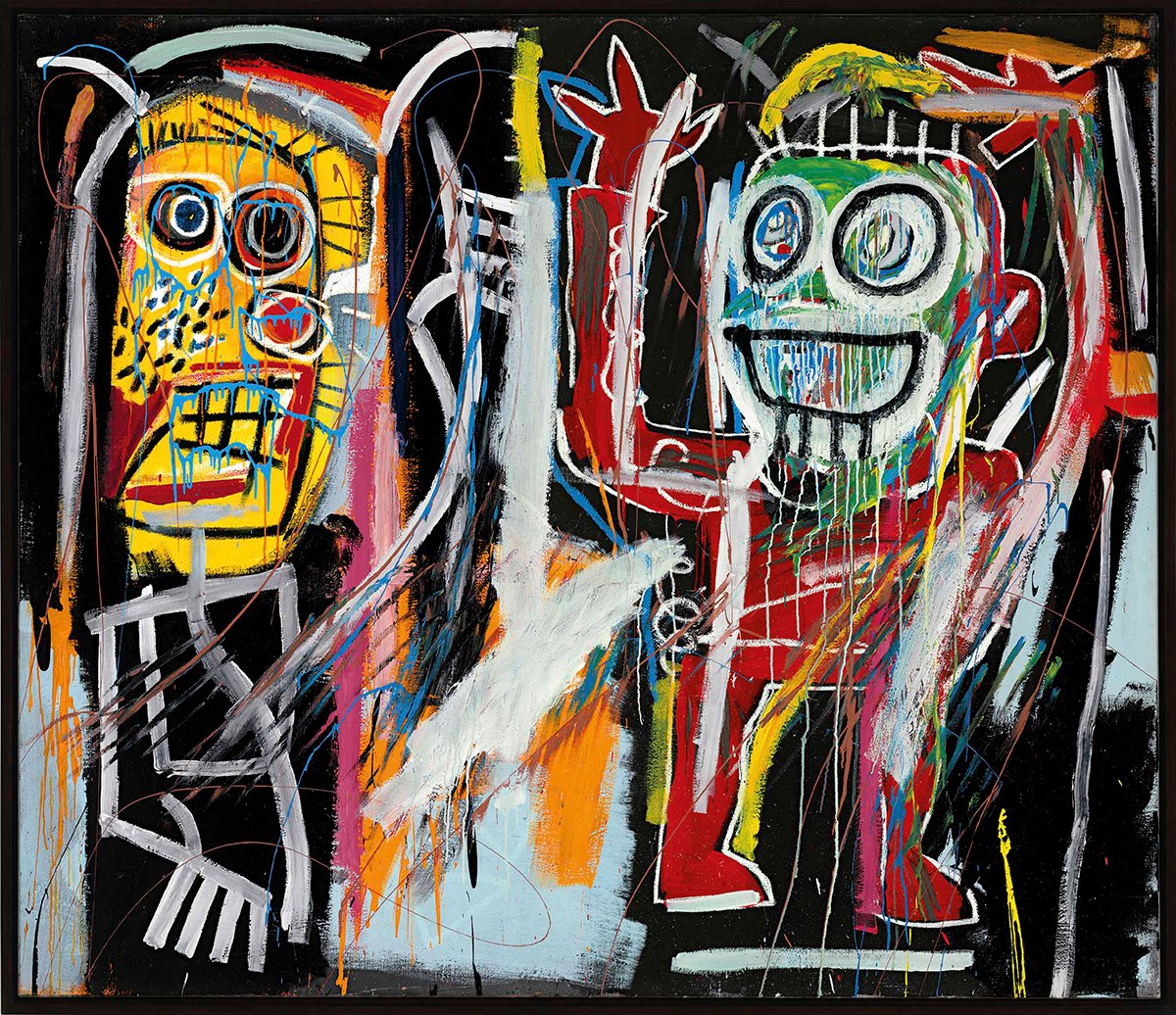
Through “Obnoxious Liberals”, Basquiat boldly critiques capitalism, showing us its victims – helpless and exploited. Detailing dollar signs, a cowboy hat, and a “Not For Sale” sign, Basquiat signals the heavy hands of mainstream White-American culture.The painting’s strong message spins predominantly around racial oppression, as suggested by the dark-skinned victim on the left.
Picasso’s influence on Basquiat is apparent, with striking parallels to the iconic “Guernica”, shedding light on heart-wrenching suffering under ruthless authority. In “Obnoxious Liberals”, Basquiat presents to us the raw and real art scene he lived in – massively monetized.
He weaves in his signature street art charm through the handcuffed “Samson”, reminiscent of his renowned SAMO© tag. The figure exposes themes of exploitation and depersonalization both in the commercial art industry. Through the clever cluster of colors and elements like the cowboy hat and dollar signs, Basquiat critiques the demographics of the capitalist art market. His bold critique stands out, marking a period in art history characterized by massive production and capitalist domination.
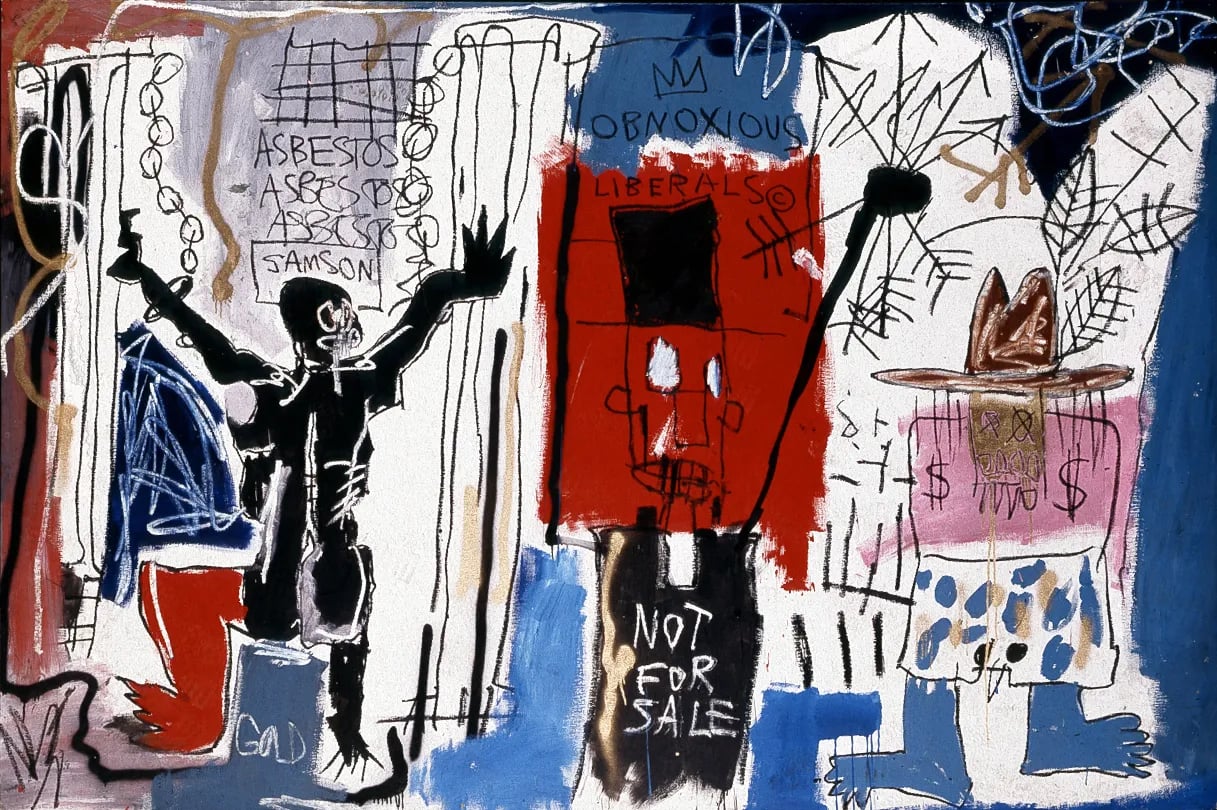
“A Panel of Experts” is notable for its raw, chaotic depiction of a feud between two women that were intimately linked to Basquiat’s life. The painting oozes conflict. Punches flying, blood spattering, explosions – each tells a riveting story of raw passion and discord. One characteristic aspect is the intense application of black paint, giving parts of the canvas an appearance of being almost redacted. Amidst this dark expanse, arrows, names, and Basquiat’s signature crown can be seen.
But this isn’t just artistic flourish – each mark serves its purpose. The imagery isn’t abstract; it’s autobiographical. A showdown at a New York nightclub, bitter rivals locked in a hostility. The stick-figure-esque representation is not just any women – it’s his girlfriend, Suzanne Mallouk (whom he charmingly referred to as Venus), and Madonna. The copyright symbol next to Madonna’s name isn’t misplaced either – it’s sardonic wit, alluding to her yet-undistinguished celebrity status. Their story, hence, is rendered forever in ink and paint – chaotic, intoxicating, and deeply personal. This intense canvas serves as a vivid snapshot into Basquiat’s life, his encounters, and their influence on his work.
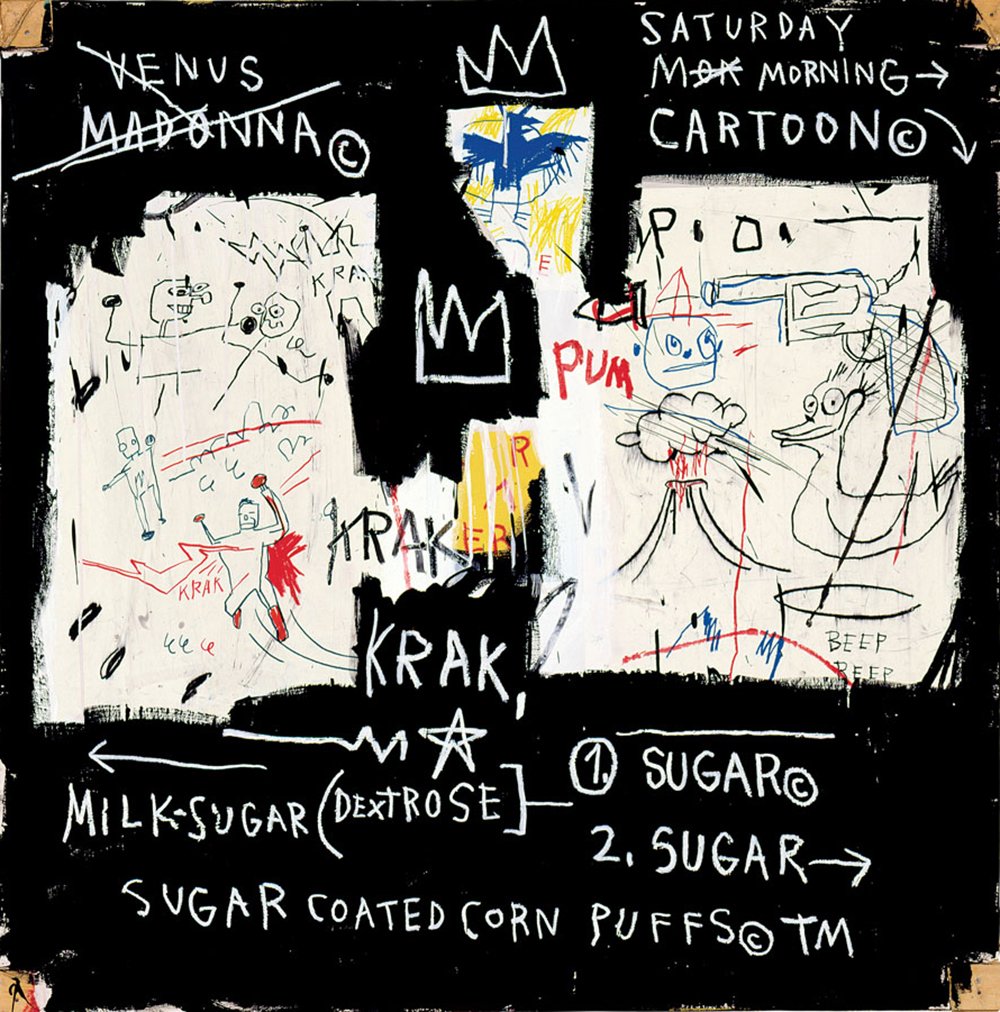
“Warrior” speaks a distinct visual language. It’s full of raw emotion, its creation seemingly done in a burst of spontaneous inspiration. Look closer. The backdrop is a riotous blend of yellow and blue, applied vigorously with a brush. It creates a vibrant setting for the subject, outlined in spray paint and oil stick. Basquiat then fills the figure in with hurried sweeps of acrylic, enhancing its intense energy.
This painting challenges conventional perspective. The figure seems to blend into the ground, amplifying the warrior’s explosive force. The central figure is a commanding gladiator, holding up a sword flauntingly, truly embodying the warrior spirit.
“Warrior’s” unique allure set a record-breaking sale of $41.7 million at a 2021 Christie’s auction in Hong Kong – the highest price ever achieved for a Western artwork in Asia. Proof, indeed, of the enduring fascination with Basquiat’s genius.
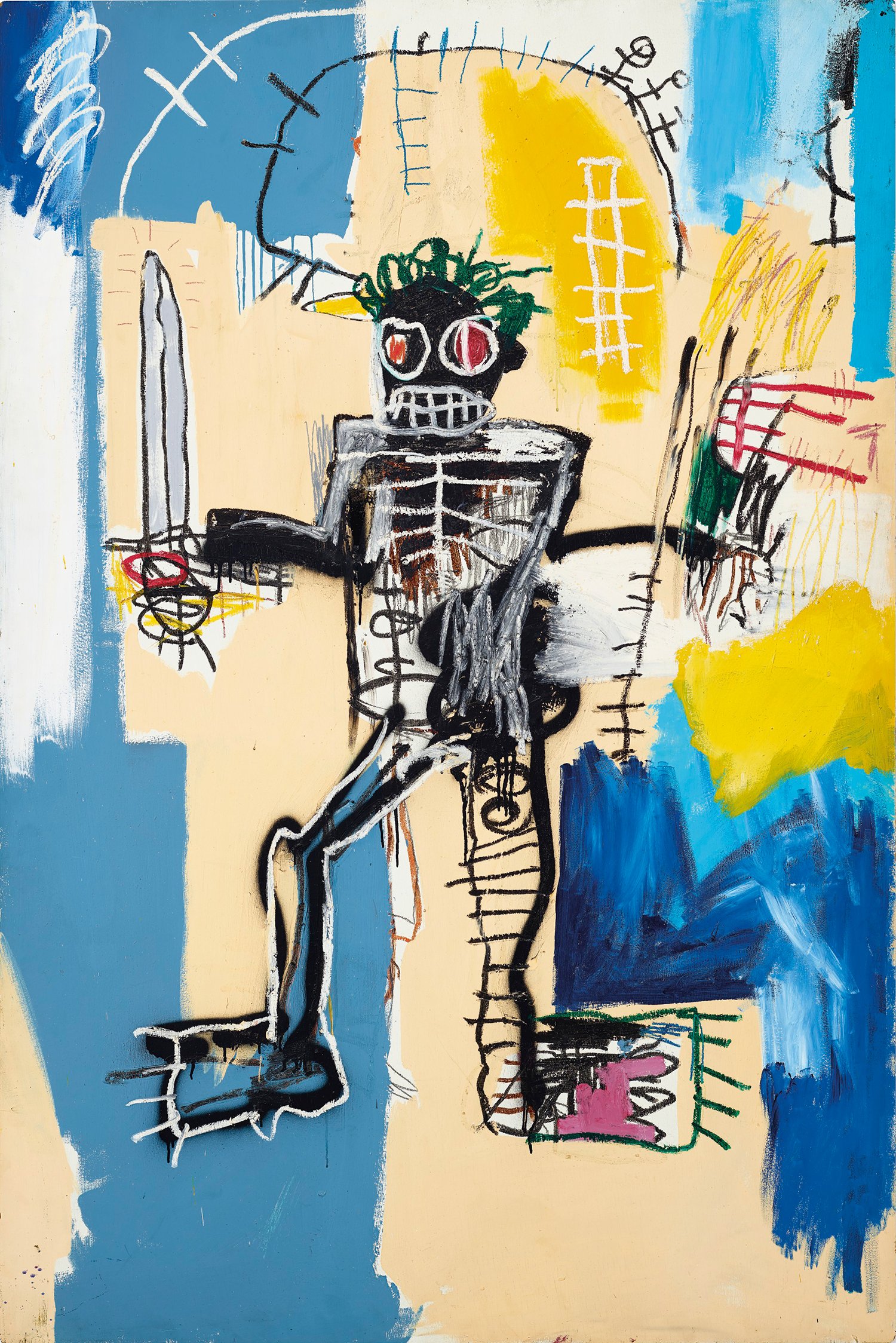
“Tuxedo” shimmies between contrasting cultures, like a hip-hop track playing on an antique gramophone. It gives a nod to the budding voices of Black poets and early rappers. You feel the duality – the life of a Black man navigating a White world and vice versa. Peek at its aesthetic. It’s a visual remix, spitting out verses in image and text form. It’s Basquiat laying down a beat that salutes hip-hop and rap culture.
Look up. That grand crown perched at the pinnacle isn’t just a cool graffiti tag. No, this is Basquiat breaking free. He shakes off the relentless information overload that street life throws at him. He crafts a regal crown, symbolic of emancipation.
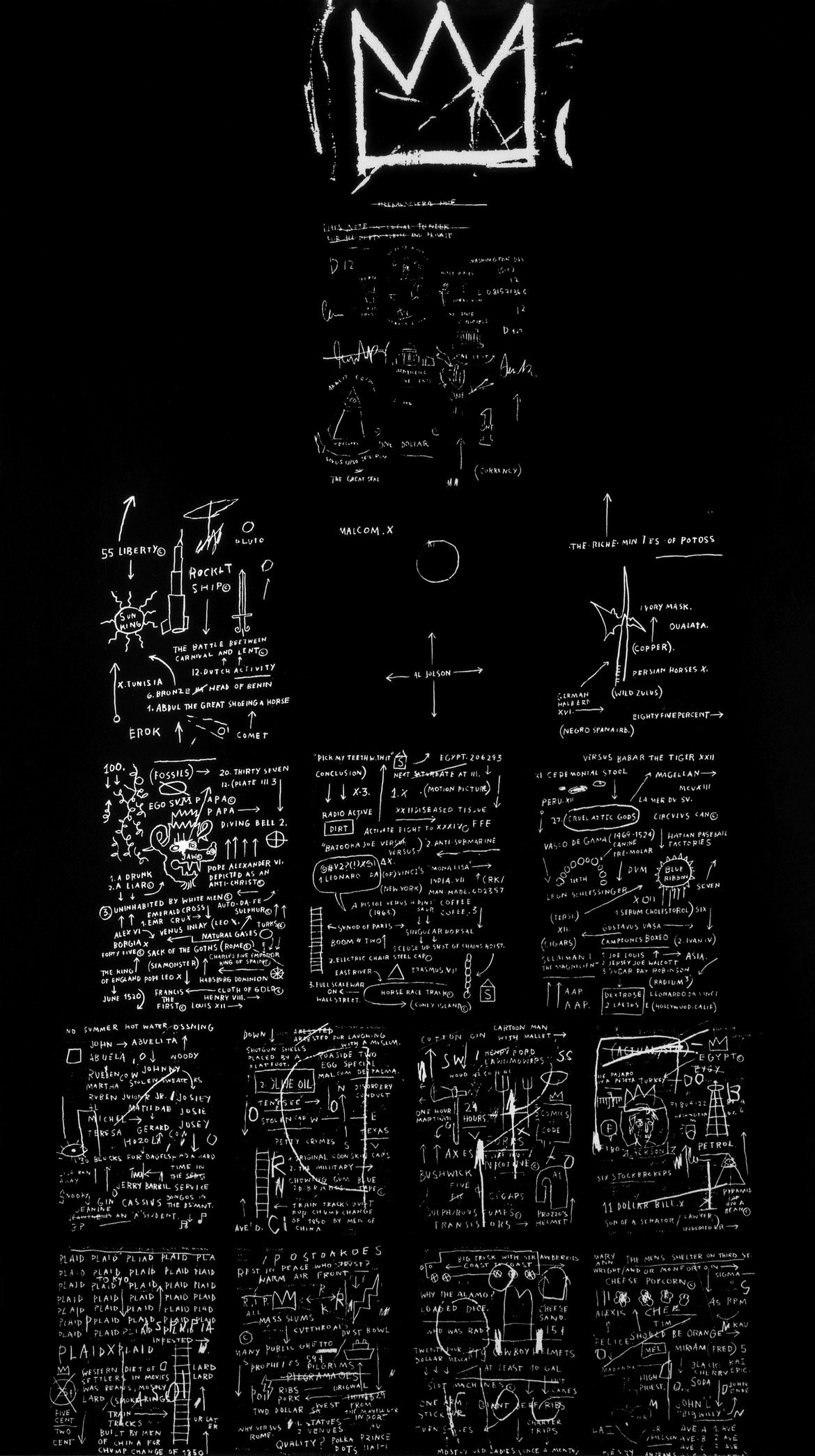
Basquiat, as a Black artist in a dominantly White art world, was deeply concerned with race relations, identity, power structures, and social dichotomies. The crown symbol in his work embodies these themes by celebrating Black identity, cultural achievements, and challenging the status quo through proudly crowning his heroes, and even himself, within the contemporary art scene.
It can also be seen as a way for him to convey his own aspirations and his quest for recognition in the art world. The crown in Basquiat’s works directly communicates his respect and admiration for the accomplishments and resilience of Black culture and stands as a form of empowering affirmation.

“In This Case” remains a pinnacle of Basquiat’s career. At 22 years old and already an internationally recognized neo-expressionist.
This large, six-by-six foot canvas boasts a gigantic skull. The striking crimson backdrop enhances the vibrant tones of the heated gaze and the noticeably green teeth. The skull’s fractured anatomy only amplifies the impact. Basquiat’s recurrent fascination with human heads is well-documented; he was intrigued with the face as a portal. A transition from the physical exterior to the deeply rooted psychic and emotional spheres.
“In This Case” concluded a compelling series of monumental skull compositions that spanned between 1981 and 1983. However, these were not simple representations of mortality but rather powerful, unescapable echoes of memories.
In a noteworthy event in May 2021, “In This Case” was auctioned at Christie’s for an astounding $93.1 million, almost doubling its expected value of $50 million.
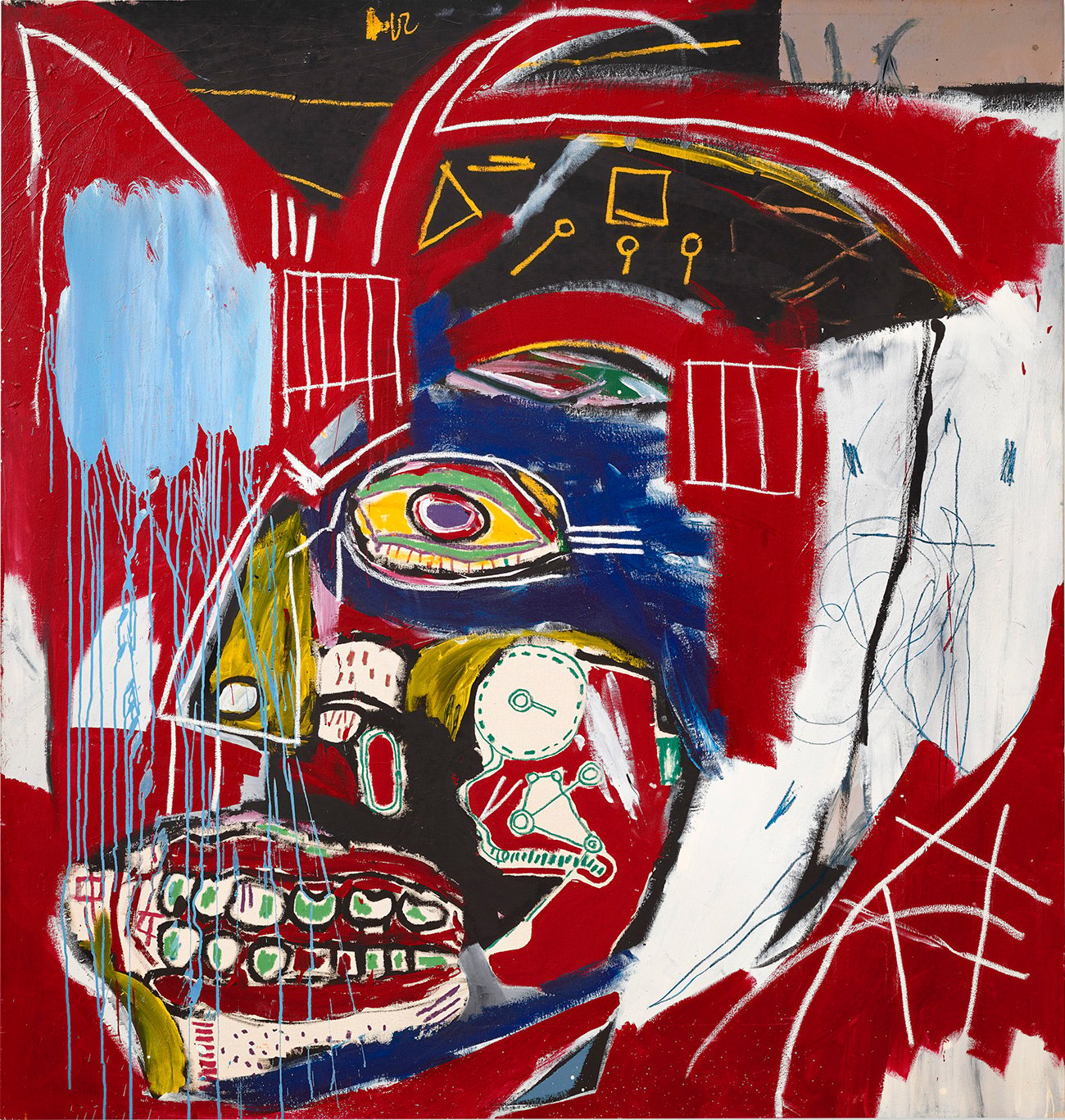
The eye-catching piece, “Pez Dispenser” features a majestic dinosaur wearing a crown. It’s rendered in street art style, fused with hints of neo-expressionism – classic Basquiat! Why a dinosaur and why a Pez dispenser? Here’s where Basquiat’s creativity comes in. The “Pez” in the title refers to the well-liked candy, Pez. This sugary treat came in fun, character-shaped dispensers, making it a staple of American pop culture.
The crown-topped dinosaur also beams symbolism, a common feature in Basquiat’s work. The crown is frequently seen in his pieces, normally symbolizing power or control. This fusion of everyday inspiration with layered symbolism is true Basquiat brilliance. So, it’s more than a fun dispenser, it’s a symbolic street-art emblem stitched into the high art realm. “Pez Dispenser” blends fun and familiarity with critical social commentary, exploring the power dynamics in our society.
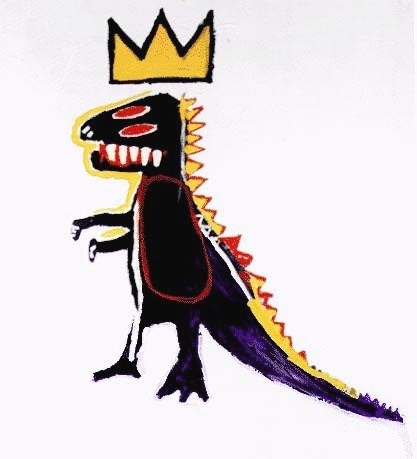
“Now’s the Time” marked a turning point in Basquiat’s career. These three words, now synonymous with his work, shout his arrival at the pinnacle of international acclaim. This piece hits home instantly, crossing all boundaries with an impact that feels as fresh today as it did in 1985.
In these three words, Basquiat lays claim to his own moment in history. He aligns himself with the roster of celebrated Black artists he admired. “Now’s the Time” – a phrase that has become iconic in relation to his work, underlines the innovative power of his then groundbreaking, now recognized artistic style. This is Basquiat saying, “Now is always the time”.
The artwork shows Basquiat moving from the vibrant, chaos-loaded style of his street art to a more refined composition. He scrawls an array of inscriptions on a stark, phantom black wood backdrop. “Now’s the Time” exudes an invisible magnetic pull, drawing the viewer into Basquiat’s ultimate expressive world. A world that celebrates the timeless allure of bebop and jazz, transfixing us with the same sensational ecstasy as Basquiat himself must have felt while creating it. In essence, “Now’s the Time” isn’t just a message from Basquiat’s era, it echoes and resonates into the present, reminding us that great art is always relevant.
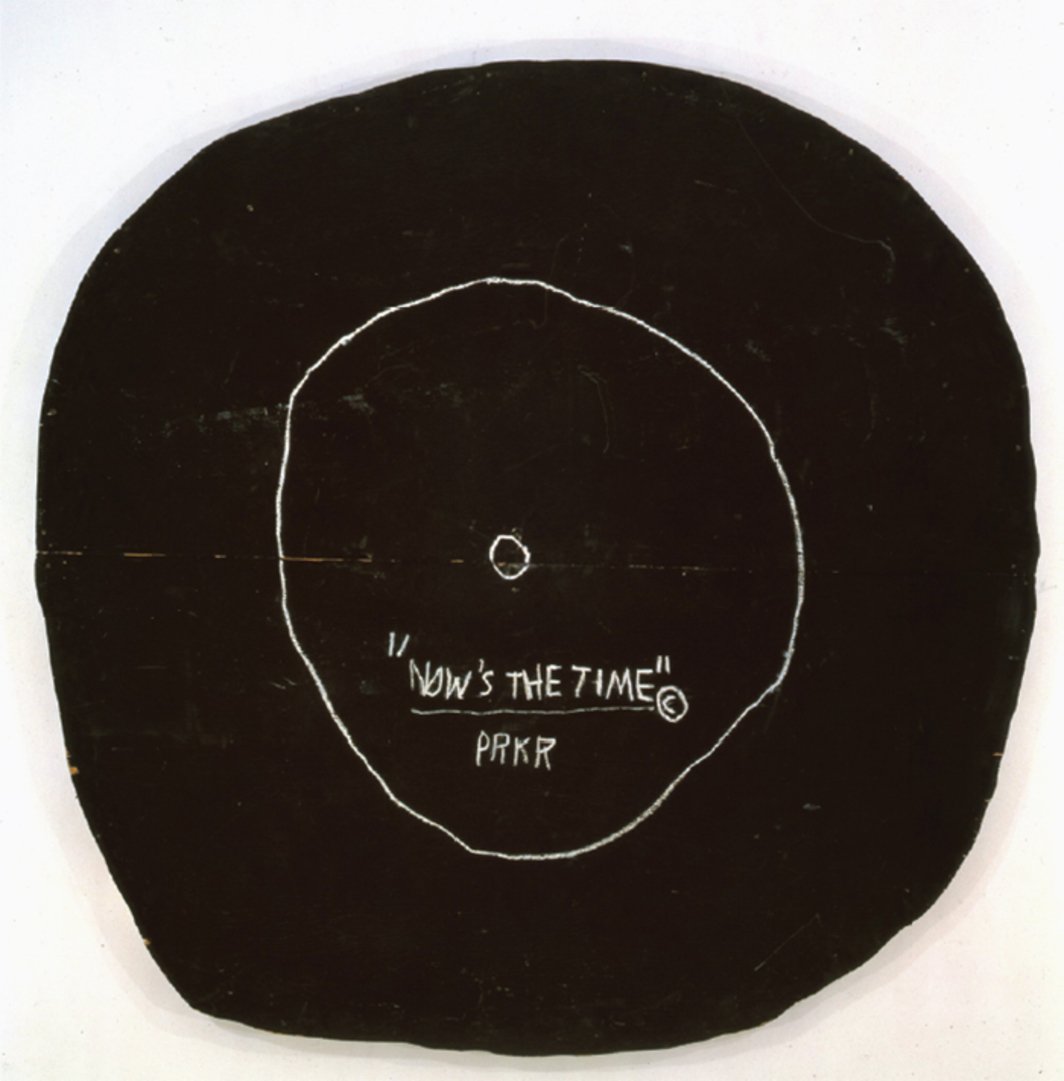
“Self-Portrait” reflects Basquiat’s obsession with self-image and personal identity. The fragmented reality depicted sets it apart. The unusual proportions, with the head being significantly larger than the rest of the body, echo the innocence seen in children’s doodles. The scattered paint drips, varied brushstroke directions, and chaotic movements show Basquiat’s exploration through the canvas’ deceptive space.
It also displays his admiration for modern artists like Pablo Picasso. It’s unusually dense and rich in details, bearing higher artistic value compared to Basquiat’s other pieces. The soft pastel backdrop contrasts starkly with the bold figure featuring dark, electrifying hair and bared teeth. It’s as if the painting is alive, reaching out to us with open arms.
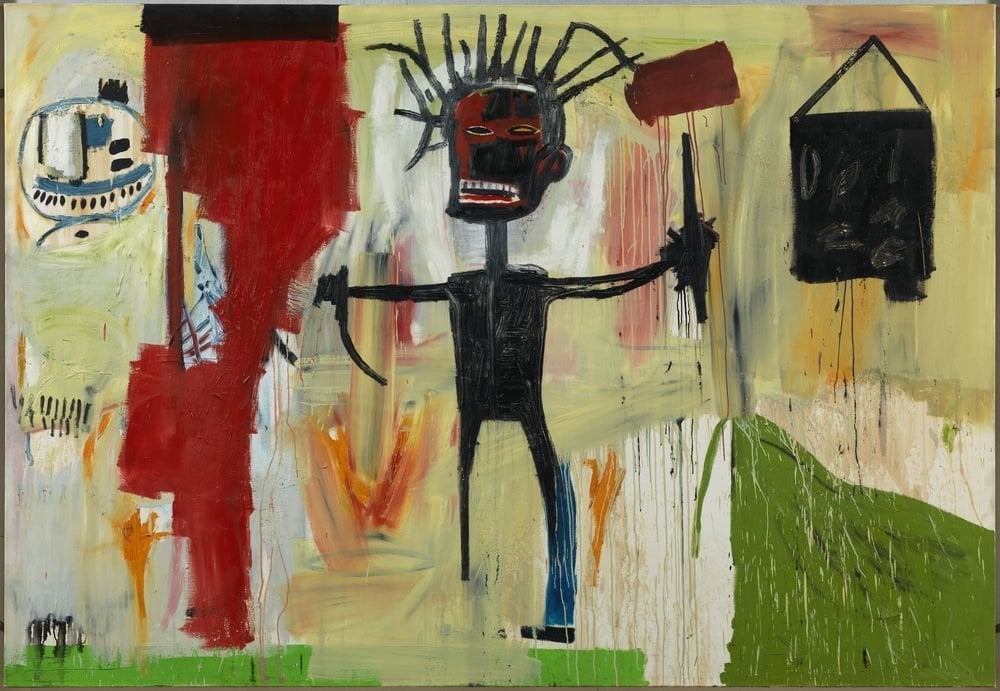
“The Dingoes that Park their Brains with their Gum” blooms with pulsating cerulean blue, evocative of the city walls serving as Basquiat’s canvas during his street art days under the tag SAMO©. The vivid color backdrop lacks depth intentionally, helping the dingoes to almost float off the frame, a tribute to the crucial potency and expressive strokes of graffiti art.
The choice of the subject, the dingo – a breed of Australian wild dog, isn’t random either. Known for their solitary existence and uncanny knack to collaborate for survival, the dingoes strike a parallel with Basquiat’s life on Brooklyn’s tough streets post his departure from home at the age of seventeen.
Cherished one moment and chased away the next, the uncertainty of existence mirrors the unpredictable life of street scavengers and dingoes alike – a metaphor not too subtle for the keen eye. Basquiat’s deep interplay of personal experiences, and artistic evolution amalgamates to create this rich visual narrative that continues to intrigue his audience, and will likely do so for many generations to come.
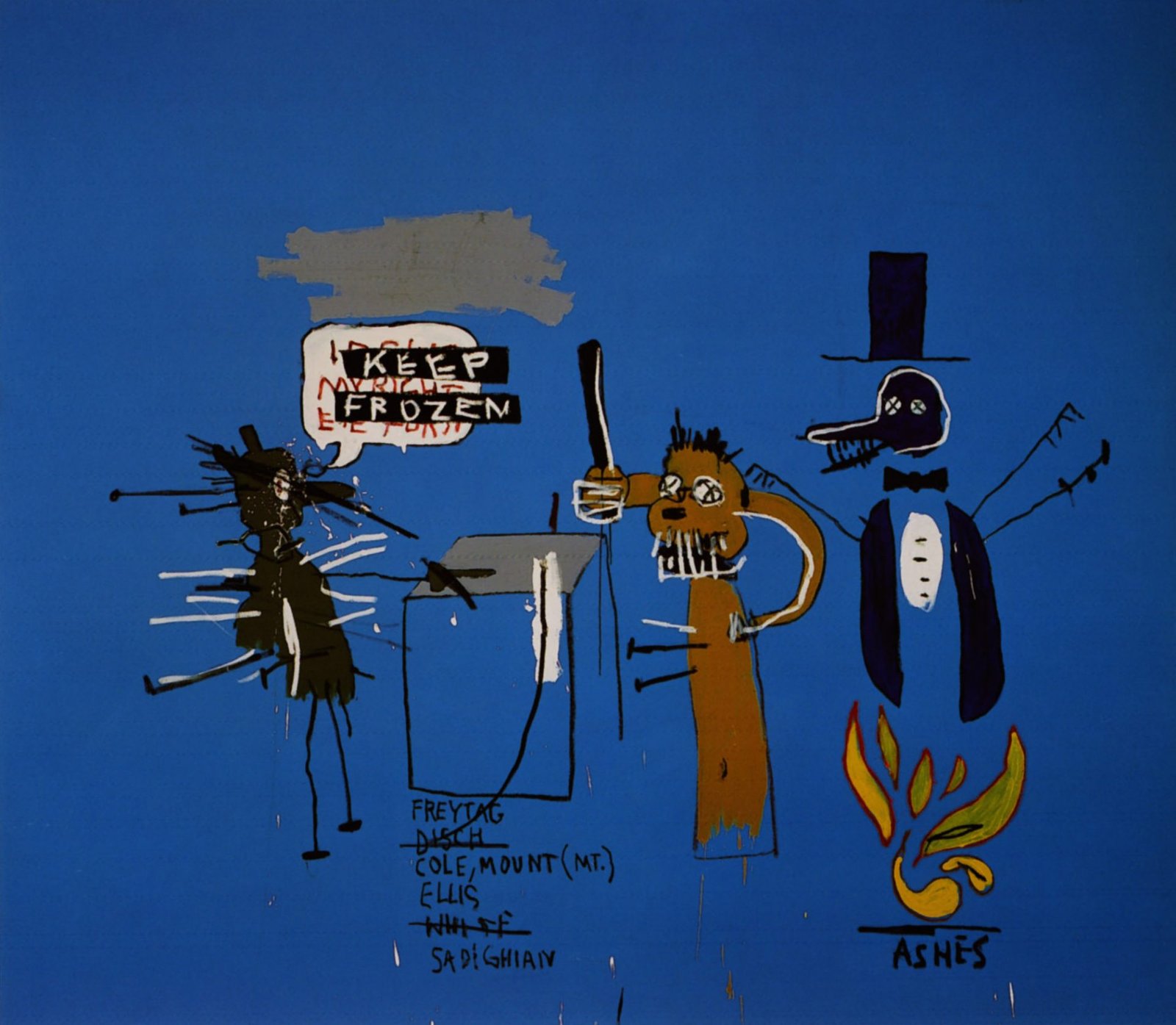
“Riding With Death” is a chilling title for one of Jean-Michel Basquiat’s last works. The painting is pretty simple compared to his earlier works. Basquiat shows an African-American man on top of a White skeleton against a basic, grainy beige background. The whole painting has more to it than meets the eye. It’s filled with references to culture, history, and social issues.
The man on top seems biographical – perhaps an image of Basquiat himself. It shows a flipping of power structures. But paired with the skeleton, it also seems a bleak message. It hints at a lack of hope for a better future in society. This shows us, ever so subtly, the artist’s cynicism and feeling of inevitable doom in an unfair world.
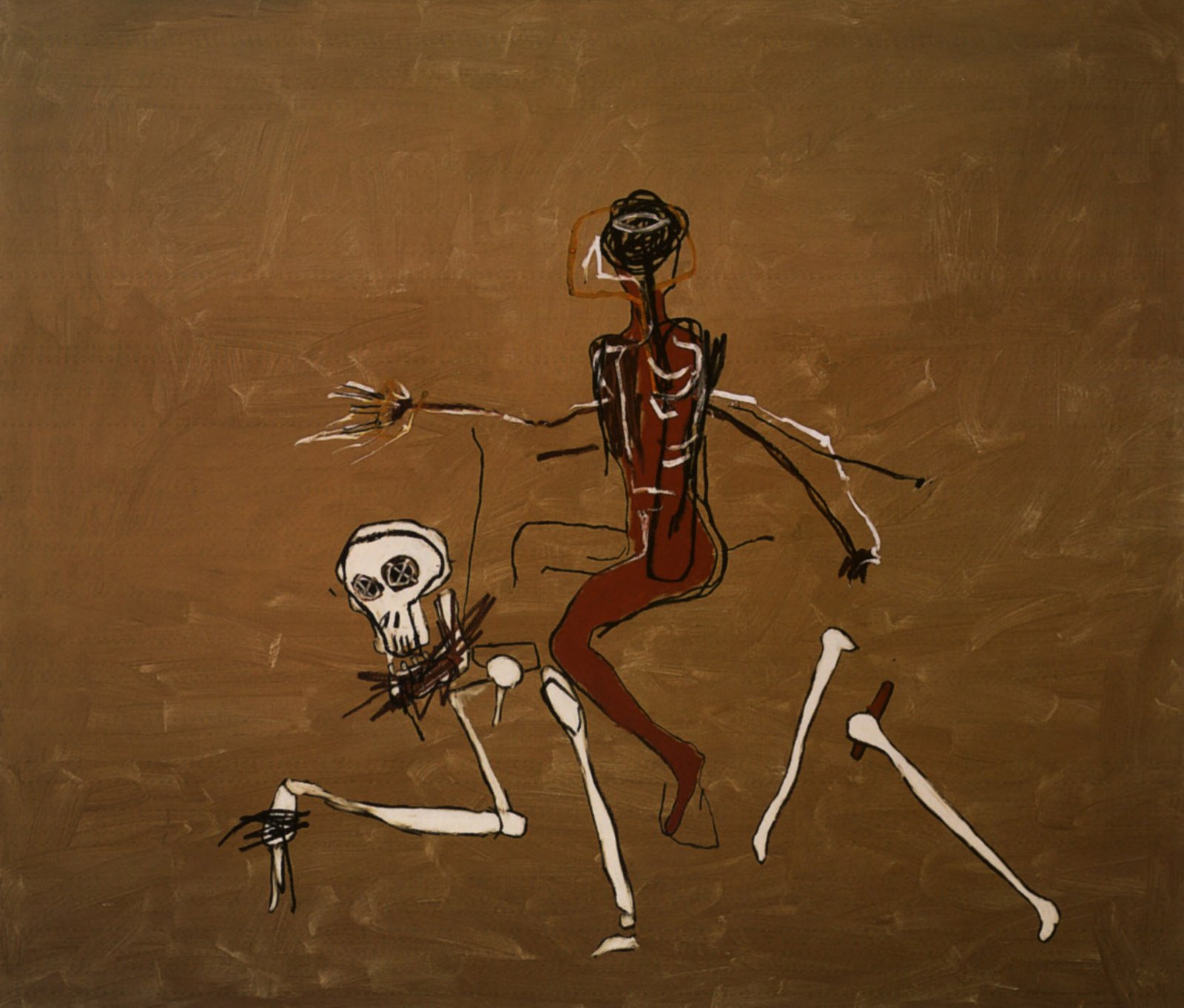
As we reflect on the life of Jean-Michel Basquiat, his premature departure at the youthful age of 27 leaves a lasting impact. Even though his artistic career spanned just ten short years, Basquiat revolutionized the art scene. His enchanting and evocative creations still captivate us today.
Basquiat lived a wild, messy life, much like his art, filled with creativity and vulnerability that ultimately took its toll. His shocking death in 1988 rocked the art world, but also shone a light on his incredible artwork, propelling him to fame like the great artists of history – a timeless figure, inspiring today’s and tomorrow’s artists.
His paintings, full of raw feeling, echo in our shared awareness, pushing us to confront tough truths about society and ourselves. They are powerful and touching tributes to an amazing artist we lost too soon. They perfectly capture the powerful effect of talent, passion, and originality.
Even after death, Basquiat remains a mystery, a force that keeps challenging the norm, refusing to be easily defined. His artistry lives on, reminding us that real art survives, timeless and always impactful, long after the artist is no more. Through his art, Jean-Michel Basquiat keeps living – just as vibrant and influential as before.
